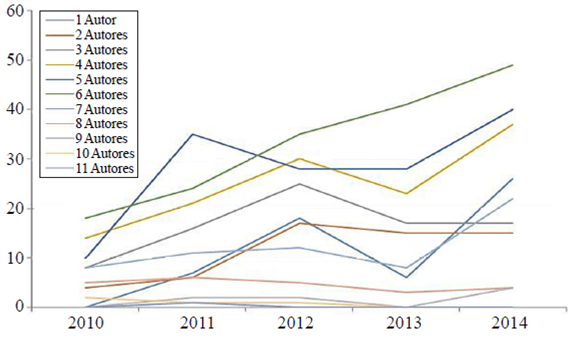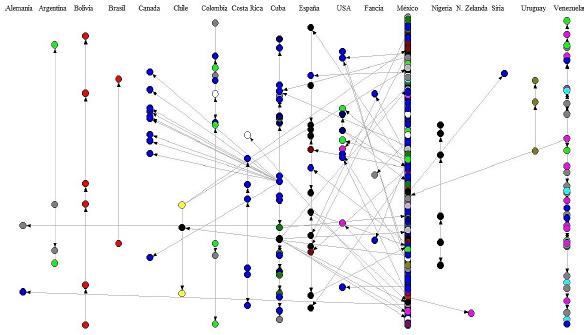Servicios Personalizados
Revista
Articulo
Indicadores
-
 Citado por SciELO
Citado por SciELO -
 Accesos
Accesos
Links relacionados
-
 Similares en
SciELO
Similares en
SciELO
Compartir
Revista mexicana de ciencias agrícolas
versión impresa ISSN 2007-0934
Rev. Mex. Cienc. Agríc vol.6 no.8 Texcoco nov./dic. 2015
Articles
Analysis of scientific collaboration in papers published by the Mexican Journal of Agricultural Sciences. I
1Campo Experimental Valle de México-INIFAP. Carretera Los Reyes-Lechería, km 18.5. A. P. 10. C. P. 56230. Chapingo, Texcoco, Estado de México. Tel: 01 800 044 22 22 Ext. 85353. (navarro468@yahoo.com.mx).
2Posgrado en Desarrollo Rural-Colegio de Postgraduados. Carretera México-Texcoco, km 36.5 Montecillo, Estado de México. Tel: (595) 9520288. (nunezej@colpos.mx).
The process of generating or build a scientific journal aims to influence the dissemination of the work of researchers of various regions and countries. The objective of this paper was to analyze the importance of the Mexican Journal of Agricultural Sciences, INIFAP, as an instrument of knowledge construction; through social networks. The Mexican Journal of Agricultural Sciences (REMEXCA) is of Open Access Open Journal System (OJS), as manager of editorial processes. The analysis is based on information published by the journal during 2010-2015, groups were categorized as: areas of knowledge, by knowledge source community of employees, main partner institutions with publications, researches agglomeration, by area of knowledge, main collaborating institutions with publications, collaborating countries, linking researchers of other countries, nodal degree in the scientific community partners, social complexity, knowledge network in REMEXCA, nodal degree, reticular complexity, intermediation analysis of reciprocity and trust and click analysis. Some of the conclusions were: a) scientific journals are an important tool to identify and analyze the construction of scientific communities, through their partnerships; b) construction of these communities are made based on inputs of sociability, objective and subjective, with which inputs such as trust, cooperation and affiliation, among others are managed; c) these communities are not unchanging and are continually changing over time; d) analysis of these communities through social network analysis (SNA) as a social intervention approach opens the possibility to explore knowledge management process. The journal has increased 70% in publishing scientific papers, national and international author that are on the National Research System (AS), 70% publish in the journal, of the 10 journals in the agricultural area, found within the catalog of scientific journals of the National Council of Science and Technology, contained within the best national and international levels and, the national and international visibility is one of the best.
Keywords: diffusion; knowledge areas; researchers; scientific journal; scientific papers
El proceso de generar o construir una revista científica tiene como objetivo incidir en la difusión de los trabajos de investigadores(as) de diversas regiones y países. El objetivo de este documento fue analizar la importancia de la Revista Mexicana de Ciencias Agrícolas del INIFAP, como instrumento de construcción del conocimiento; a través, de redes sociales. La Revista Mexicana de Ciencias Agrícolas (REMEXCA) es de acceso abierto Open Journal System (OJS), como gestor de procesos editoriales. El análisis se basó en la información que publicó la revista del año 20102015, se categorizaron grupos como: áreas de conocimiento, procedencia por áreas de conocimiento de la comunidad de colaboradores(as), principales instituciones colaboradoras con publicaciones, aglomeración de investigadores(as), por área de conocimiento, principales instituciones colaboradoras con publicaciones, países que han colaborado, vinculación entre investigadores(as) de otros países, grado nodal en la comunidad de científicos(as) colaboradores (as), complejidad social, red de conocimiento en la REMEXCA, grado nodal, complejidad reticular, intermediación análisis de reciprocidad y confianza y análisis de cliqué. Algunas de las conclusiones fueron: a) las revistas científicas son un importante instrumento para identificar y analizar la construcción de comunidades científicas, por medio de sus colaboraciones; b) la construcción de estas comunidades se realiza con base en insumos de sociabilidad, objetivos y subjetivos, con los cuales se gestionan insumos tales como la confianza, cooperación y filiación, entre otros; c) dichas comunidades no permanecen inalterables y continuamente se van modificando con el tiempo; y d) el análisis de estas comunidades a través del análisis de redes sociales (ARS), como un enfoque de intervención social, abre la posibilidad para explorar proceso de gestión del conocimiento. La revista ha tenido un aumento en 70% en la publicación de artículos científicos, autores(as) nacionales e internacionales que están en el Sistema Nacional de Investigadores(as) 70% que publican en la revista, de las 10 revistas del área agrícola, que se encuentran dentro del catálogo de revistas científicas del Consejo Nacional de Ciencias y Tecnología, se encuentra dentro de los mejores índices nacionales e internacionales, y la visibilidad nacional e internacional es una de las mejores.
Palabras clave: áreas del conocimiento; artículos científicos; difusión; investigadores(as); revista científica
Introduction
Sixty years ago came the first volume of the Journal of Technical Agriculture in Mexico (ATM), founded in July 1955 by the General Directorate of Agriculture, which depended on the Ministry of Agriculture and Livestock (SAG) of the time. In 2010 it changed its title to Mexican Journal of Agricultural Sciences (REMEXCA) of the National Research Institute of Forestry, Agriculture and Livestock (INIFAP), the oldest journal in agricultural science in Mexico and Latin America and publishes related agricultural science writings and the like, which may be in the form of a scientific paper, research note, growing trial or description. It is bilingual and the periodicity is once every 45 days, including 70% of scientific papers and the rest 30%; essays, research notes and descriptions of cultivars.
The REMEXCA is of open access, through the software Open Journal System (OJS) as manager of editorial processes and developments that follow international journals, to minimize the activities of the editorial process and publication of the journal, on the following aspects: shipping item, selecting the editor and allocation of adjudicators, sending requests for opinions, the review process by the editor, making editorial decision by the publisher, editing, process layout, process observations to the author, publication of the article and creating new number and publication. Manuscripts by topics, keywords, author, year of publication, table of contents, summaries are located, among others.
The arbitration journal consists of researchers recognized by national and international scientific community and covers every area of knowledge of agricultural science. The manuscripts are peer reviewed and edited by a group of experts, leaders in their field (as it marks the norms of National Council for Science and Technology (CONACYT), designated by the editorial board. each manuscript is approved by two adjudicators and since 2010 is trying to subject every paper to five disseminators.
The journal content is produced from the point of view of science, technology and innovations is quotable. In addition, standards or instructions for authors include the structure of the various manuscripts published. It also includes the criteria for the preparation of references. The citation in the journal has been prepared based on the standards of the American Forage and Grasslands Council, Forage and Grazing Terminology Committee, Council of Science Editors, Style Manual Committee, Crop Science Society of America, Weed Science Society of America, Nomenclature Committee, US Department of Agriculture-Natural Resources Conservation Service, Soil Science Society of America, Terminology Committee, Royal Botanic Gardens and ASA-CSSA-SSSA. Currently; the REMEXCA is included in the Index of Mexican Journals of Scientific and Technological Research of the National Council of Science and Technology (CONACYT) as well as the United States Department of Agriculture of America (USDA), City Factor, Scopus, and the Directory of Open Access Journals (DOAJ). As well as four of the major online booksellers Online, Scientific Electronic Library on Line, such as projects SciELO-Mexico, SciELO Citation Index (CI SciELO), Network of Scientific Journals of Latin America and the Caribbean (REDALyC), including Brazil, Portugal and Spain, The Essencial Electronic Agricultural Library (TEEAL) of Cornell University, Periodic Class Latindex, Hela of the National Autonomous University of Mexico (UNAM), Dialnet- of the University of La Rioja, Spain, VINITI-Russia, CAB International, repository of the Chamber of Deputies and ACUEDI- Peru (COPE, 2014; Sangerman-Jarquín, 2015).
In 2014, the REMEXCA obtained the online ISSN: 2007- 9230 which represents a further step in this journal. The print ISSN: 2007-0934, granted by the INDAUTOR, with the change to REMEXCA title in 2010. Also, internet platforms such as Skype: remexca and Facebook: Remexca and the website of the REMEXCA (http://cienciasagricolas.inifap.gob.mx/) have served as dissemination tools of the journal so that, from 2013 to 2015, a total of 539 413 visits to May of this year (Sangerman-Jarquín, 2015).
Metodology
The REMEXCA is a dynamic instrument for the diffusion of knowledge and its scope as a means of scientific papers diffuser has grown. In this case, from 1955 to 2008, the journal published 308 writings. From 2008 to 2015 1067 works were published; that is, in just 7 years, REMEXCA published 70% more papers since its first edition. The main contribution of this literature (72%) was by researchers of INIFAP, including the National Research System (SNI). La Jornada (2011) refers to the SNI in 2009, the System of Public Research Centers of Conacyt with 4 222 members in their scientific and technological personnel. Of these, 2 041 were doctors, 791 masters and 1 367 graduates or engineers.
In this template, 1 600 were members of the SNI, an organization of leading scientists from around the country. In terms of productivity, CONACYT have 2169 papers published in refereed journals; REMEXCA in this sense is a refereed publication. The Conference Report (2012) of the seven different types of products that researchers of the SNI must be generated, 99.1% were books, book chapters and papers.
Results
These developments reflect a process of evolution in the journal per se, but also exposes the process of social agglomeration scientific communities, as more and more researchers of agricultural sciences send papers to REMEXCA to be arbitrated, sanctioned and published. Making a cut in the diffuser REMEXCA, from 2010 to 2015 exercise shows that a total of 785 manuscripts was published (Table 1), with the years 2011 and 2014 which published 22.04% and 27.26%, respectively, of the works on this period. By 2015, the numbers do not include all volumes, since the counting was on February.
Table 1 Number of papers per year in the REMEXCA-INIFAP (2010-2015).
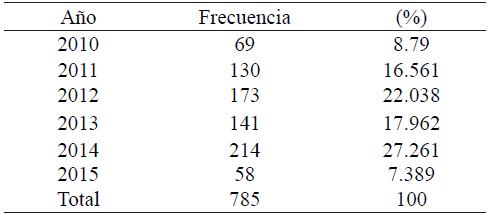
Elaboración con datos de REMEXCA-INIFAP.
The main areas of study that have contributed most of the works published in the REMEXCA are Fitotecnia 33.7%, Rural Development 10.4%, Economics 8.6%, Hydrosciences 6.5%. This indicates that the fields where it is conducting further investigations production (Table 2). Noteworthy that, the category Fitotecnia, could be subdivided further on issues such Phytopathology, Plant Genetics, Physiology, Plant Breeding and Plant Health; in turn the category of Rural Development could be further subdivided into several sub-themes such as innovation and technology transfer, extension work, organization, project evaluation, and others.
Table 2 Publications in the area of knowledge REMEXCA-INIFAP (2010-2015).
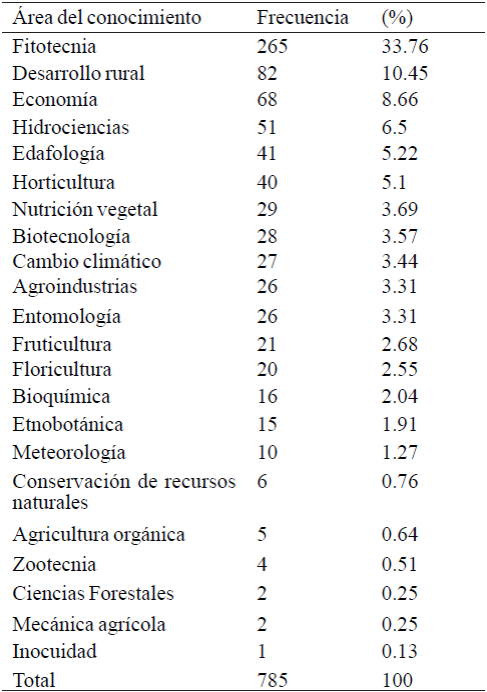
Elaboración con datos de REMEXCA-INIFAP.
These knowledge areas have different dynamics of production over time. For example, the area of plant breeding, had its biggest participation in 2012 (21.51%) for 2014, this contribution was 18.49%. In the case of rural development, most production was in 2014, with 36.59% of the total contributions that had between 2010 and 2015. In the case of economics, maximum contributions occurred in 2014 (32.35%) (Table 3).
Table 3 Number of papers by knowledge, by year, on the REMEXCA-INIFAP (2010-2015).
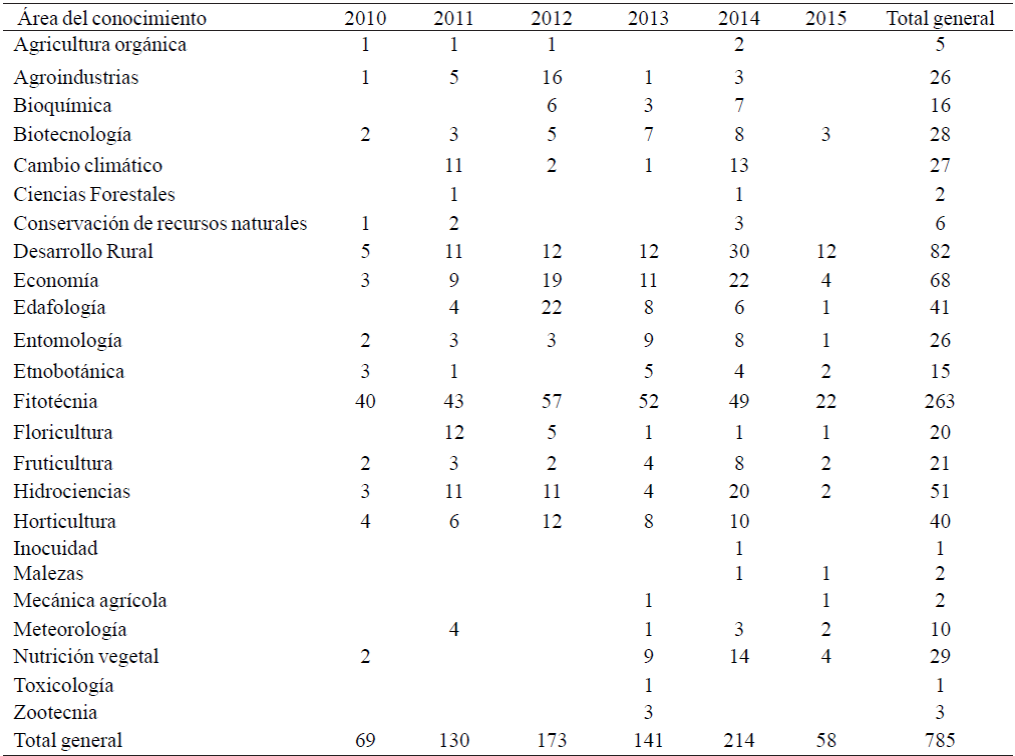
Elaboración con datos de REMEXCA-INIFAP.
This differentiation in the production of scientific papers in the REMEXCA-INIFAP, for area-year noted certain dynamic grouping within the scientific community. According to the data analyzed, the area of Plant Science has the largest number of researchers (34.67%), followed by Rural Development (7.73%), Hydrosciences (7.21%), Economics (6.75%) and Horticulture (6.02%), among others (Table 4).
Table 4 Origin per areas of knowledge, of the community partners of REMEXCA-INIFAP (2010-2015).
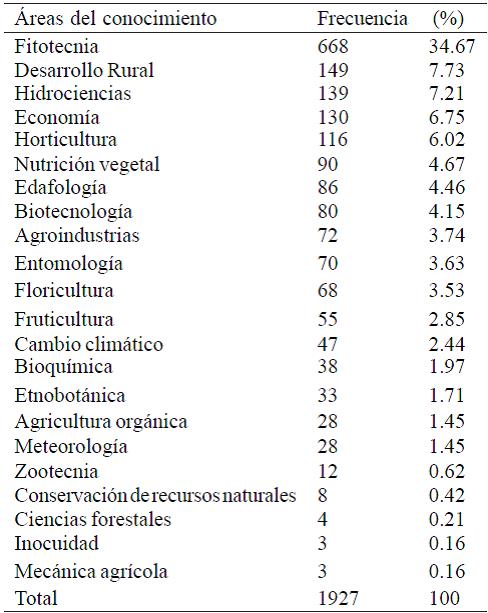
Elaboración con datos de REMEXCA-INIFAP.
These fluctuations in production and collaboration of scientific papers are a logical product of the editorial line of the journal, but also point to social management dynamics between areas (as well as the emergence of "invisible colleges"). While the editorial line of the journal marks the kind of work that's published, the diversity of issues that are published in the REMEXCA-INIFAP that gives guideline to test on different degrees of social agglomeration, each of the knowledge areas involved in the journal (Figure 1). In this case, the "neighborhoods" with a greater degree of agglomeration are the plant breeding, rural development, hydrosciences, economics and horticulture (Kennedy, 2004; Moylan, 2015).
According to the data analyzed, 71.59% of REMEXCA publications were generated by groups of three to six authors, 12.99% were written by the same or larger groups seven author; 7.77% were works by two authors, and 7.64% by a single author (Table 5).
Table 5 Number of authors per item. REMEXCA-INIFAP (2010-2015).
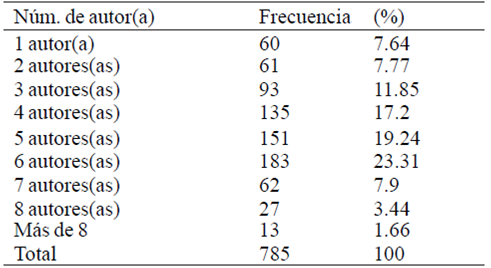
Elaboración con datos de REMEXCA-INIFAP.
As for the annual dynamics of publications, number of authors, between 2010 and 2014, a higher percentage (26.77%) in 2014, followed by 2010 (20.65%), in 2011 and 2012 was observed, the participation rates were 17%.
The year 2010-2014, the publication of papers that participated 6, 5 and 4 author (469) represented an increase of119.16% compared with the published papers in the same period, from 1, 2 and 3 author (214), and 359.8% compared to papers published by 7 or more author (102) (Figure 2).
Aguado et al. (2009) indicated that, according to CONACYT (2006), Mexico remains one of the countries where the trend towards individual participation has higher percentages than the collective. However, REMEXCA, as the agricultural sector journal, presents an opposite trend, where groups of 4, 5 and 6 co-authors are predominant. Although, Aguado noted that the overall rate of co-authorship, by discipline, the Mexican scientific production (1990-2004), warns an average differential between disciplines where Physics has a co-authorship on averaged of 8.8 and 3.9 for Agriculture.
Institutional linkage
On the other hand, scientific production that comes together in a journal as REMEXCA can also be seen from an institutional point of view, as groups of researchers published in either journal are, for the most part, assigned to an institutional system. In the case being analyzed, 68% of published papers came from national institutions (Table 6).
Table 6 Major collaborating institutions with publications in the REMEXCA-INIFAP (2010-2015).
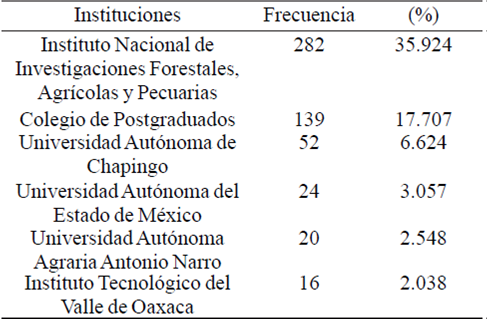
Elaboración con datos de REMEXCA-INIFAP.
While most of the works published in the REMEXCA come from Mexican institutions and research education, a substantial part comes from international institutions. In this direction, although the participation of Mexican institutions is the strongest, as a Mexican journal, the participation of Venezuelan institutions (1.92%), Cuba (1.3%) and Spanish (0.83%) is observed, among others (Table 7). In this context, the percentage of authors foreign grew, on average, just over 10% a year over the past 5 years. In 2009, the foreign papers authors totaled 13% and in 2013 came to 18%, papers of Chile, Colombia, Germany, Cuba, Venezuela, Argentina, Bolivia, Brazil, Chile, Colombia, Costa Rica, Cuba, Dominican Republic , Ecuador, Honduras, Paraguay, Uruguay, Spain, USA and France.
Table 7 Number of employees in the REMEXCA-INIFAP (2010-2015) by country.
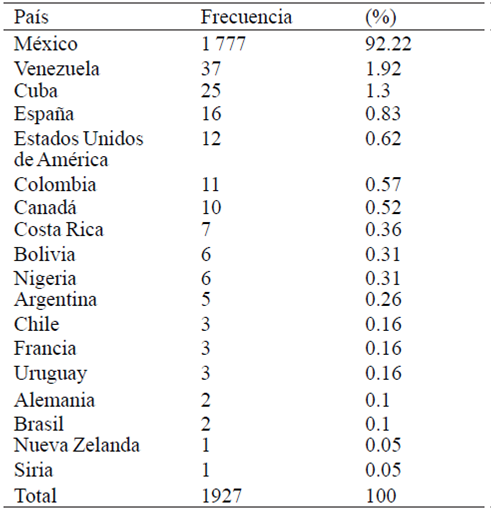
Elaboración con datos de REMEXCA-INIFAP.
In Figure 3, various dynamic associations are presented. The Mexican researchers, from different areas of knowledge, are the present and relate more visible with researchers of the United States, Spain and Cuba. Another visible group is researchers from Venezuela, who have a large scientific production, but little association with the researchers in other countries. The scientific production is in areas of ethnobotany, plant breeding, hydrosciences, soil science and horticulture. An interesting group is the group of Cuban researchers that have strong partnerships with researchers Canadians in the areas of plant breeding, agribusiness, soil science, horticulture, fruit growing and Rural Development. For its part, Colombia participates only with national groups in areas of plant breeding, soil science, horticulture, agro and plant nutrition. The same case is presented with Nigerian researchers in the area of rural development.
Conclusions
The presence and success of the Mexican Journal of Agricultural Sciences as a dissemination tool and as an integrating instrument of national and international scientific community that grows every year is determined by various factors, a) its diffusion has been instrumental in the existence of the medium; leadership that managed to unite these dynamics of the journal: author ; arbitrators; editors, redactors; translators, national and international committee and the editorial board of the journal, a scientific community that is interested in publishing in the journal; b) a reading community of research results are published in the journal.
The confluence of author and co-authors in the REMEXCA, by area and year, give a clear indication of the movement of the processes of intellectual synergy among institutions and research groups.
In this context, the process of agglomeration number of authors also indicates this movement of collaboration, therefore, of social construction. In this case, 4-6 author (59.75% of published papers) there is a large social composition of papers that have written papers that authors compounds 1-3 and equal to or higher than 7 author.
On this regard, the collaboration between researchers and research group, according to their nationality, showed a complex picture made up of local and regional research interests: national communities (Venezuela, Colombia, Nigeria) and international communities (Cuba Canada, Mexico-Cuba, Mexico-Spain).
New approaches are made, for example, what factors motivate- or limit - more the scientific production in some areas than in others, and in some periods, more than others? Why are there areas where the publication is minimal or heavy? What is the dynamic partnership that prevails in the areas of knowledge that shaped the REMEXCA? What are the social inputs that allow this type of collaboration and how can they be analyzed? Such questions will be addressed in the second part of this document.
Literatura citada
Aguado, L. E.; Rogel, S. R.; Garduño, O. G.; Becerril, G.A.; Zúñiga, R. M. F. y Velázquez, Á.A. 2009. Patrones de colaboración científica a partir de redes de coautoría. Convergencia, Revista de Ciencias Sociales. IA. Universidad Autónoma del Estado de México (UAEM). Rev. Convergencia 225-258 pp. (COPE). 2014 Kennedy, D. 2004. Moylan, E. 2015. SciELO, 2015 Nicholas, D. 2014 [ Links ]
Committee on Publication Ethics (COPE). 2014. Statement on inappropriate manipulation of peer review rocesses. http:// publicationethics.org/news/cope-statement-inappropriate-manipulation-peer-review-processes (consultado enero, 2015). [ Links ]
Kennedy, D. 2004. Intelligence science: reverse peer review? Science. 5666(303):1945. DOI:10.1126. [ Links ]
La Jornada. 2011. Centros Públicos de Investigación, una red mexicana de conocimiento descentralizado. Junio 21, 2011. 2-4 pp. [ Links ]
La Jornada. 2012. Creció en 2009 número de investigadores en México, pero su producción fue mínima: ASF. Agosto 24, 2011. 36-38 pp. [ Links ]
Moylan, E. 2015. Innapropriate manipulation of peer review. BioMed Central blog. http://blogs.biomedcentral.com/bmcblog/2015/03/26/manipulation-peer-review/ (consultado marzo, 2015). [ Links ]
Nicholas, D. 2014. Peer review: still king in the digital age. Learned Publishing. 28(1):15-21. DOI: 10.1087/20150104. [ Links ]
Programa de las Naciones Unidas para el Desarrollo (PNUD). 2001. Informe sobre Desarrollo Humano (2001). Poner el adelanto tecnológico al servicio del desarrollo humano Mundi-Prensa. 344 pp. [ Links ]
Revista Mexicana de Ciencias Agrícolas (REMEXCA). Volúmenes 2010-2015. [ Links ]
Robertson, R. 2003. Glocalización: tiempo-espacio y homogeneidad-heterogeneidad. Cansancio del Leviatán: problemas políticos de la mundialización. Madrid: Trotta. 187 pp. [ Links ]
Russell, J. M.; Madera, J. Ma. J. y Ainsworth, S. 2009. El análisis de redes en el estudio de colaboración científica. REDES- Revista hispana para el análisis de redes sociales. 17(2):654- 677. [ Links ]
Sangerman-Jarquín, Dora Ma. 2015. Editorial. Rev. Mex. Cienc. Agric. 6(1):1-8. [ Links ]
Sanz, M. L. 2003. Análisis de redes sociales: o como representar las estructuras sociales subyacentes Apuntes de ciencia y tecnología. 7:21-29. [ Links ]
SciELO. 2015. Cienciometría de evaluadores- ¿serán finalmente reconocidos Cienciometría de evaluadores- ¿serán finalmente reconocidos http://blog.scielo.org/es/2014/05/14/cienciometria-de-evaluadores-seran-finalmente-reconocidos/? (consultado marzo, 2015). [ Links ]
SciELO. 2015. A 350 años de publicación científica: desde el Journal des Sçavans y el Philosophical Transactions hasta SciELO (consultado marzo, 2015). http://blog.scielo.org/es/2015/03/05/350-anos-de-publicacion-cientifica-desde-el-journal-des-scavans-y-el-philosophical-transactions-hasta-scielo/ . [ Links ]
Serna, E. 2014. Genealogía de la soberbia intelectual. Ed. Taurus. México. 453 pp. [ Links ]
Received: February 2015; Accepted: August 2015











 texto en
texto en 


